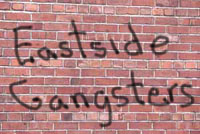Street Gangs
WHAT IS A GANG?

Gangs are usually formed according to ethnic or racial guidelines, although there seems to be a current trend to form gangs for economic reasons. Traditional youth gangs structured along ethnic lines include Hispanic, Asian (e.g. Vietnamese, Laotian), Black, Pacific Islander (e.g. Tongan, Filipino), and White (e.g. Skinheads) gangs. A gang is a group of people who form an allegiance for a common purpose and engage in violent, unlawful, or criminal activity. A gang may or may not claim control over a certain territory in the community.
FACTORS CONTRIBUTING TO GANG AFFILIATION
Parents should look for change in behavior and lifestyle of their child. Contributing factors placing a youth at risk include ineffective parental skills, history of family gang involvement and evidence of parental abuse or neglect. This type of dysfunctional family atmosphere affects the youth's school behavior, leading to poor academic achievement and early anti-social behavior. The at-risk youth now becomes a personal risk. The youth will display low self-esteem and may begin experimenting with drugs and alcohol. As the youth searches for his or her new identity, he usually isolates himself with others experiencing similar social and personal problems. Youth ex-posed to these influences without guidance has a tendency to accept and legitimize his activities. The youth will flourish and strive in his or her newly found status. This self rewarding status guarantees the youth's indulgence with the gang culture.
SIGNS OF GANG INVOLVEMENT
Certain signs indicate gang involvement in our community or on school campuses. Parents should be aware of these warning signs and should be ready to employ the appropriate prevention and intervention strategies. These warning signs include:
- An "informal" dress code that is followed by your child, and his or her associates (hats, scarves, jewelry, shoelaces, colors, tattoos and insignias, etc.).
- Street slang, use of new nicknames and hand signs.
- Newly acquired and unexplained "wealth" often displayed, worn or shared with peers.
- Graffiti on personal property, book covers, notebooks and clothing. This graffiti may include initials, numbers, names, expressed racism or hatred of religious groups or sexual preferences.
HOW TO DISCOURAGE YOUR CHILDREN FROM JOINING GANGS
Discourage your children from hanging around with gang members.Meet your children's friends. Find out who they are, what influence they have on your children and how they and your children spend their free time. If your children choose friends that are mostly from gangs, then your children are probably involved or will become involved in one also.
Occupy your children's free time. Give them responsibilities at home. Get them involved in after-school sports, city/county recreation, dance, the arts, and other busy activities.
Develop good communication with your children. Good communication is open and frequent, and it takes on a positive tone. It allows your children to come to you to discuss any topic or problem. It does not condemn or put down. Good communication allows you to tell your children that you love them.
Spend time with your children. Plan activities that the whole family can enjoy. Spend time alone with your children. Expose them to different places outside of your neighborhood: parks, museums, the beach, the mountains, camping trips, etc.
Do not buy or allow your children to dress in gang style clothing. If your children dress in gang style clothing, they are expressing an interest in gangs and will attract the attention of gangs. If they are in the wrong neighborhood at the wrong time, they could be victimized or killed.
Set limits for your children. At an early age, children need to know what is acceptable and what is unacceptable behavior. Do not allow your children to stay out late or spend a lot of unsupervised time out in the streets.
Do not allow your children to write or practice writing gang names,symbols, or any other gang graffiti on their books, papers, clothes, bodies, walls or any other place.
Teach them respect for others' property. Develop an anti-gang environment in your home. Clearly and continually begin to express to your children at an early age your disapproval of gang activity and of any family members joining a gang.
Learn about gang and drug activity in your community. Learn how gang members dress, how they speak, their behavior and their activities. Attend information meetings, read articles related to gang activity.
Be an informed parent.
WHERE TO CALL FOR MORE INFORMATION or HELP:
- Emergency - 911
- Dallas Police Gang Unit - 671-GANG
Helpful Links:
